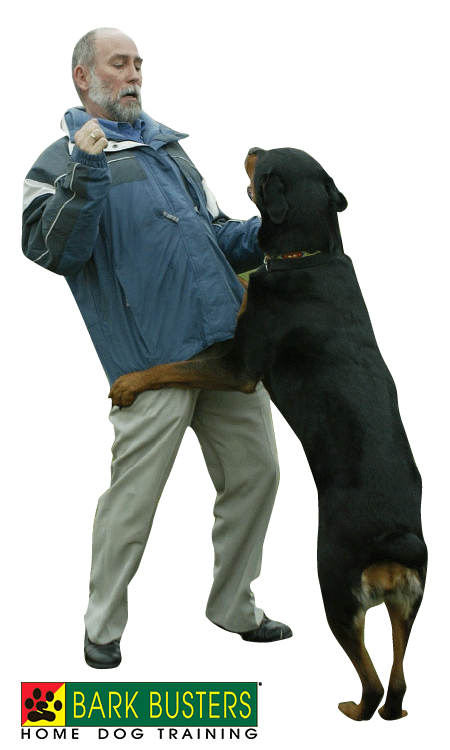Don't Confuse Your Dog!
 As Bark Busters trainers, one of the most common things we hear from dog owners is "My dog doesn't listen to me".
As Bark Busters trainers, one of the most common things we hear from dog owners is "My dog doesn't listen to me".
If you have heard or read about the Bark Busters system of training, you will know that it is founded on communication; voice tone and body language. This leverages the natural communication which works for dogs and has done for thousands of years. Dogs tend to behave consistently and respond consistently to similar triggers. Very often it is we humans who cause the problems by using a combination of inconsistent commands and differing rules depending on how busy / tired / stressed / lazy we are feeling.
The result of this inconsistency is that your dog is probably listening very hard to what you are saying, willing to do as you ask, but is totally confused about what is expected of him.
So when you think that your dog doesn't listen, it could be that you are confusing him by using inconsistent commands and failing to praise his success. For example, you may use 'no' to tell him to stop doing something, your partner may use 'stop it', your children might just shout his name. All of these commands could be interspersed with the odd 'A-ah', 'put it down', 'get off', 'stop being silly'…the list goes on.
Add to this the likelihood that you all have different rules: Some of your family allow him on the couch, some don't, some allow him on the couch at night when they are tired and can't be bothered to tell him to get off: Some allow him to jump up, some don't, some encourage him to do it, some don't mind as long as they're not wearing their best clothes, and some don't mind unless he's muddy! Some of you feed him food from the table, some don't allow him to beg, some don't mind him begging as long as you don't have guests. All of these inconsistencies create a very confused dog!
The same rules around consistency apply to training. You must use simple, clear and consistent commands, and always follow with praise for success. So, if you are training your dog to sit, the 'sit' is his command, followed by 'good boy/girl'. The whole family needs to use the same command, 'sit'. There should be no 'sit down', 'are you going to sit for me?', 'sit down, please', as you will start to confuse your dog with too many different words. If you are starting from scratch, and your dog genuinely does not understand the command, then you can use some gentle manual pressure to place your dog in the sit position, accompanied by the verbal command and then praise when he sits. Your dog will soon get the idea.
Another important point is that your dog's name is not a command. So, if you are calling your dog by shouting his name over and over again, your dog will almost certainly hear you but not be certain of what you want him to do. He may come to you – or not. Calling him in this way from the lounge to the kitchen might work as he may be interested enough to come and see what you are up to or whether you have something for him, but it may not work in the park where he is more interested in new people, dogs and smells. Decide on a recall command such as 'Rover, come!', or 'Rover, here!', use it consistently whenever you want your dog to come to you, either in the house or out and about, and remember to praise him when he does come so that he understands he is doing the right thing.
We recently met a dog owner whose dog was 'not listening to him', and whose barking was driving the owner to distraction. When we met their dog, he was barking as expected. The owner's command for stopping this behaviour was 'sit!'. The dog did indeed sit, but carried on barking. The client was exasperated by the dog's failure to stop barking. But the dog WAS actually listening to the owner and sitting as requested. He had no idea that 'sit' meant he should stop barking - and why would he? Once we had explained this to the owner he could see immediately that he was not communicating well with his dog, and was soon able to change his own behaviour.
Most people's dogs will listen once their owners learn to communicate clearly and consistently. If it helps, write down your commands so that you, and the rest of the family, know what they are and when to use them. Don't allow variables to creep in.
Of course, if you need any help, you can call us and we would be delighted to help you with teaching you how to train your dog and be consistent. We know that your dogs will thank you for it!
Bark Busters trainers have trained more than 1 Million dogs worldwide and are renowned authorities in addressing dog behaviour with all-natural, dog-friendly methods. Bark Busters training is the only service of its kind that offers International guaranteed lifetime support. With hundreds of trainers around the world, Bark Busters continues its mission to enhance the human/canine relationship and to reduce the possibility of maltreatment, abandonment and euthanasia. Contact your local Bark Busters dog trainer to see how they can help.

 Bonfire night takes place traditionally on 5th November but, as we all know, nowadays, fireworks can be seen and heard for weeks before and after that date. Whilst fireworks are attractive and exciting for humans, dogs generally are far less keen and are unable to make sense of the loud bangs and explosions taking place in their normally quiet lives.
Bonfire night takes place traditionally on 5th November but, as we all know, nowadays, fireworks can be seen and heard for weeks before and after that date. Whilst fireworks are attractive and exciting for humans, dogs generally are far less keen and are unable to make sense of the loud bangs and explosions taking place in their normally quiet lives.
 We often get called to see dogs who are in the habit of jumping up at people. It may be that they jump up at their owner, or visitors, or anyone they pass in the street! It’s a behaviour that can be, at best, embarrassing for the owner or, at worst, putting the owner at risk of criminal charges and an expensive fine.
We often get called to see dogs who are in the habit of jumping up at people. It may be that they jump up at their owner, or visitors, or anyone they pass in the street! It’s a behaviour that can be, at best, embarrassing for the owner or, at worst, putting the owner at risk of criminal charges and an expensive fine.